Artificial Intelligence in Business: Strategic Cost Planning Analysis
VerifiedAdded on 2023/04/21
|9
|2039
|371
Essay
AI Summary
This essay critically evaluates the growing role of artificial intelligence (AI) in business, with a specific focus on strategic cost planning for competitive advantage. It discusses the increasing commercialization of AI and its applications in various industries, such as recommendation engines and automated systems. The essay also addresses the challenges of implementing AI, including the need for strategic planning and investment in technical expertise. Furthermore, it examines the impact of Volkswagen's MOIA on Uber's business, using McKinsey's 7S framework to analyze potential strategy changes. The analysis covers aspects like strategy, systems, structure, shared values, style, skills, and staff, emphasizing the importance of adapting to competitive pressures and fostering innovation. The document is available on Desklib, a platform offering a wide range of study resources for students.
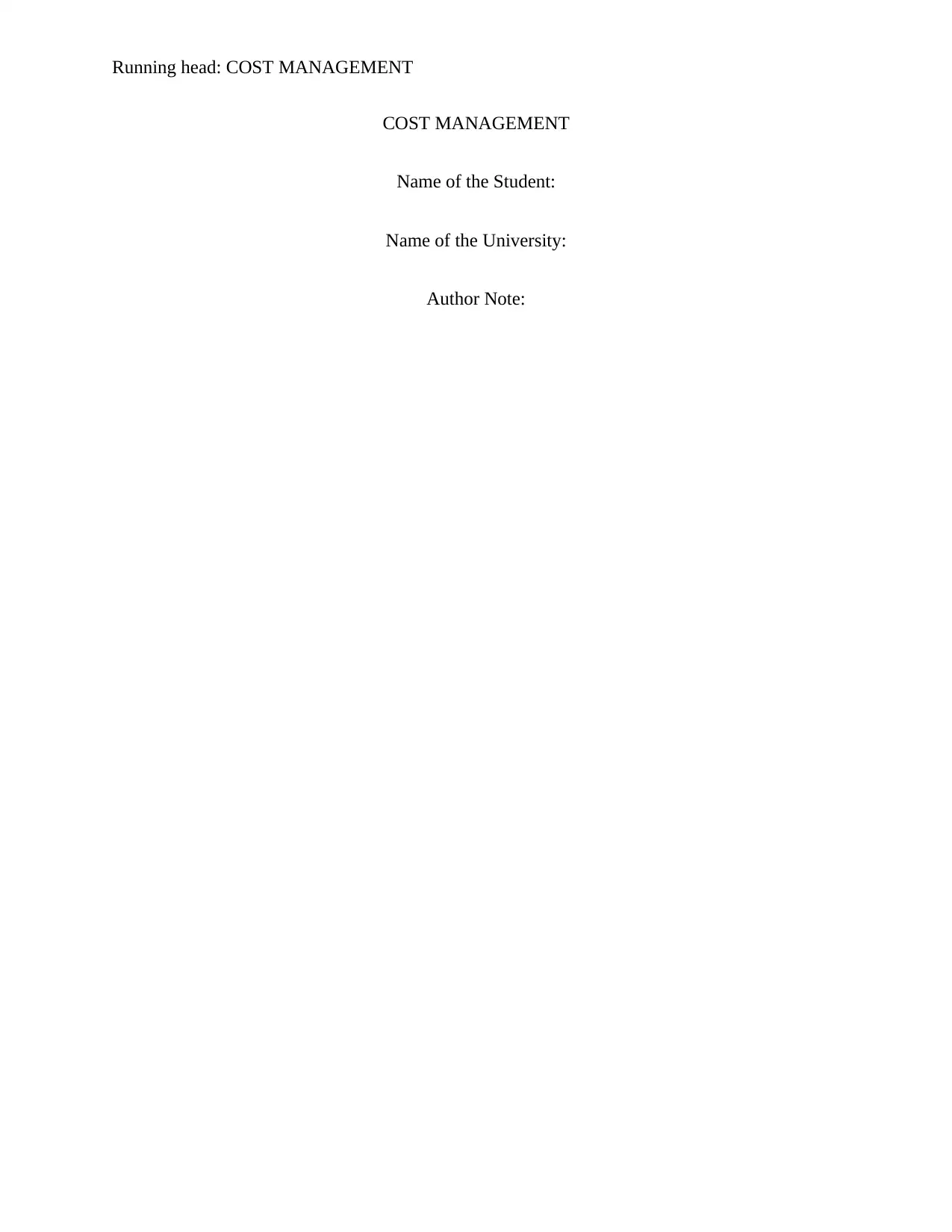
Running head: COST MANAGEMENT
COST MANAGEMENT
Name of the Student:
Name of the University:
Author Note:
COST MANAGEMENT
Name of the Student:
Name of the University:
Author Note:
Paraphrase This Document
Need a fresh take? Get an instant paraphrase of this document with our AI Paraphraser
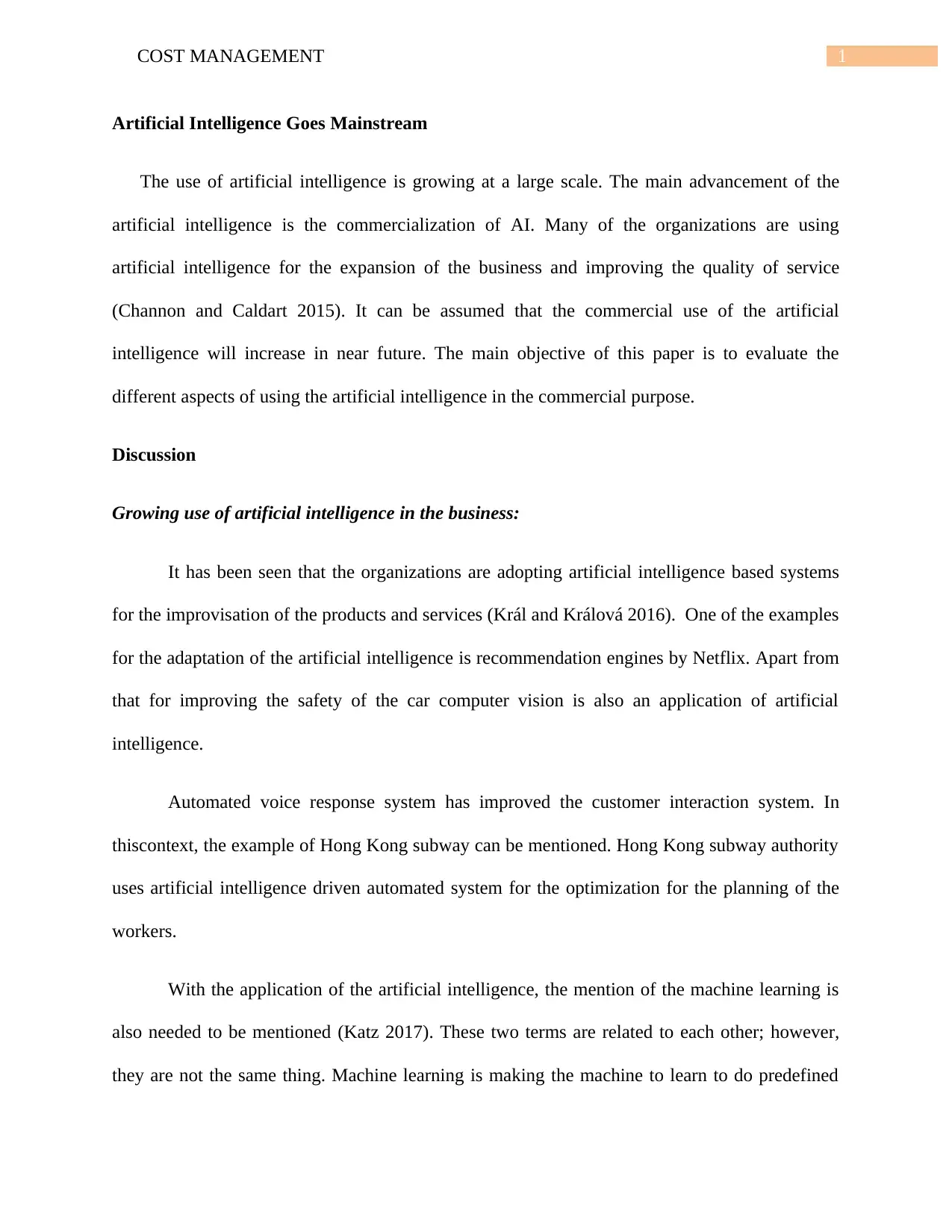
1COST MANAGEMENT
Artificial Intelligence Goes Mainstream
The use of artificial intelligence is growing at a large scale. The main advancement of the
artificial intelligence is the commercialization of AI. Many of the organizations are using
artificial intelligence for the expansion of the business and improving the quality of service
(Channon and Caldart 2015). It can be assumed that the commercial use of the artificial
intelligence will increase in near future. The main objective of this paper is to evaluate the
different aspects of using the artificial intelligence in the commercial purpose.
Discussion
Growing use of artificial intelligence in the business:
It has been seen that the organizations are adopting artificial intelligence based systems
for the improvisation of the products and services (Král and Králová 2016). One of the examples
for the adaptation of the artificial intelligence is recommendation engines by Netflix. Apart from
that for improving the safety of the car computer vision is also an application of artificial
intelligence.
Automated voice response system has improved the customer interaction system. In
thiscontext, the example of Hong Kong subway can be mentioned. Hong Kong subway authority
uses artificial intelligence driven automated system for the optimization for the planning of the
workers.
With the application of the artificial intelligence, the mention of the machine learning is
also needed to be mentioned (Katz 2017). These two terms are related to each other; however,
they are not the same thing. Machine learning is making the machine to learn to do predefined
Artificial Intelligence Goes Mainstream
The use of artificial intelligence is growing at a large scale. The main advancement of the
artificial intelligence is the commercialization of AI. Many of the organizations are using
artificial intelligence for the expansion of the business and improving the quality of service
(Channon and Caldart 2015). It can be assumed that the commercial use of the artificial
intelligence will increase in near future. The main objective of this paper is to evaluate the
different aspects of using the artificial intelligence in the commercial purpose.
Discussion
Growing use of artificial intelligence in the business:
It has been seen that the organizations are adopting artificial intelligence based systems
for the improvisation of the products and services (Král and Králová 2016). One of the examples
for the adaptation of the artificial intelligence is recommendation engines by Netflix. Apart from
that for improving the safety of the car computer vision is also an application of artificial
intelligence.
Automated voice response system has improved the customer interaction system. In
thiscontext, the example of Hong Kong subway can be mentioned. Hong Kong subway authority
uses artificial intelligence driven automated system for the optimization for the planning of the
workers.
With the application of the artificial intelligence, the mention of the machine learning is
also needed to be mentioned (Katz 2017). These two terms are related to each other; however,
they are not the same thing. Machine learning is making the machine to learn to do predefined
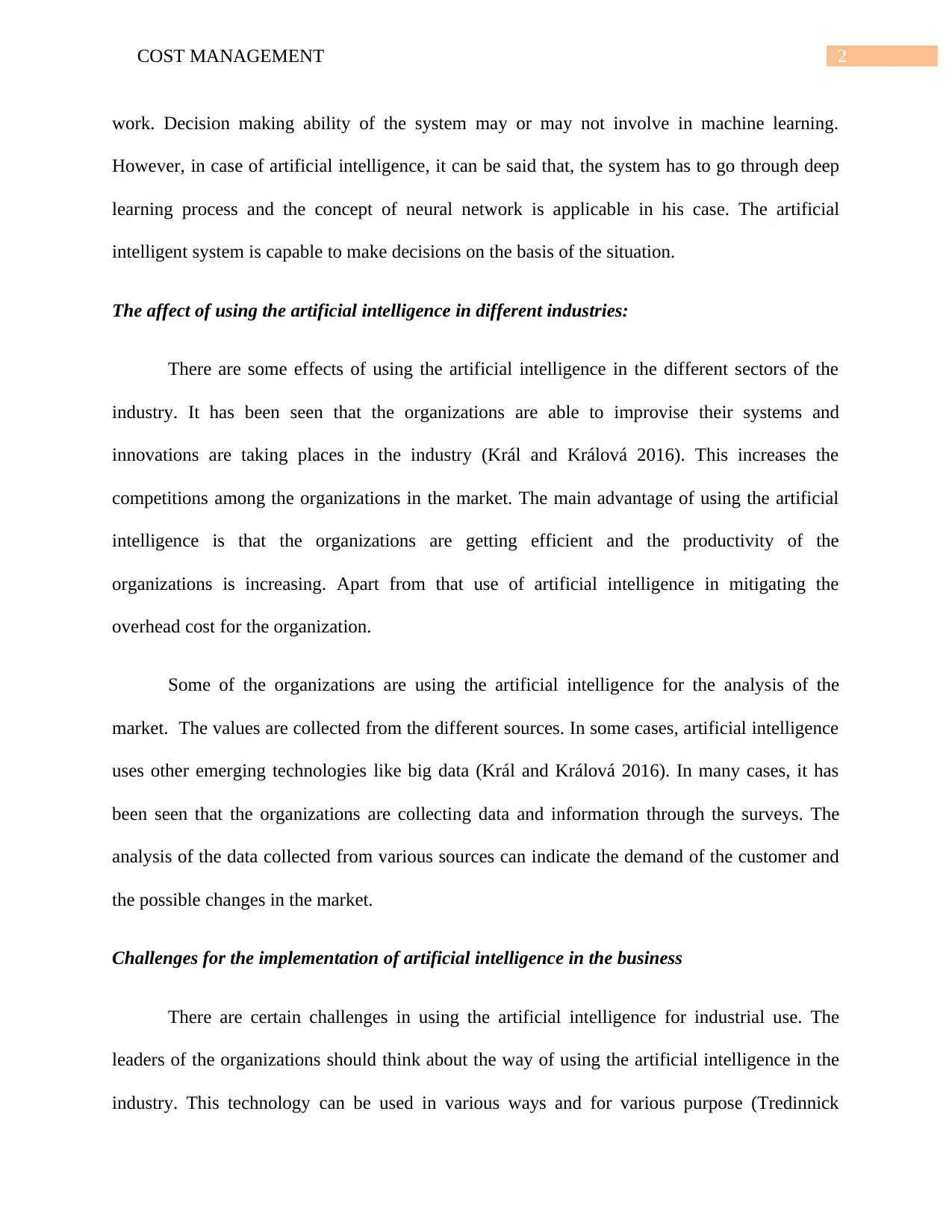
2COST MANAGEMENT
work. Decision making ability of the system may or may not involve in machine learning.
However, in case of artificial intelligence, it can be said that, the system has to go through deep
learning process and the concept of neural network is applicable in his case. The artificial
intelligent system is capable to make decisions on the basis of the situation.
The affect of using the artificial intelligence in different industries:
There are some effects of using the artificial intelligence in the different sectors of the
industry. It has been seen that the organizations are able to improvise their systems and
innovations are taking places in the industry (Král and Králová 2016). This increases the
competitions among the organizations in the market. The main advantage of using the artificial
intelligence is that the organizations are getting efficient and the productivity of the
organizations is increasing. Apart from that use of artificial intelligence in mitigating the
overhead cost for the organization.
Some of the organizations are using the artificial intelligence for the analysis of the
market. The values are collected from the different sources. In some cases, artificial intelligence
uses other emerging technologies like big data (Král and Králová 2016). In many cases, it has
been seen that the organizations are collecting data and information through the surveys. The
analysis of the data collected from various sources can indicate the demand of the customer and
the possible changes in the market.
Challenges for the implementation of artificial intelligence in the business
There are certain challenges in using the artificial intelligence for industrial use. The
leaders of the organizations should think about the way of using the artificial intelligence in the
industry. This technology can be used in various ways and for various purpose (Tredinnick
work. Decision making ability of the system may or may not involve in machine learning.
However, in case of artificial intelligence, it can be said that, the system has to go through deep
learning process and the concept of neural network is applicable in his case. The artificial
intelligent system is capable to make decisions on the basis of the situation.
The affect of using the artificial intelligence in different industries:
There are some effects of using the artificial intelligence in the different sectors of the
industry. It has been seen that the organizations are able to improvise their systems and
innovations are taking places in the industry (Král and Králová 2016). This increases the
competitions among the organizations in the market. The main advantage of using the artificial
intelligence is that the organizations are getting efficient and the productivity of the
organizations is increasing. Apart from that use of artificial intelligence in mitigating the
overhead cost for the organization.
Some of the organizations are using the artificial intelligence for the analysis of the
market. The values are collected from the different sources. In some cases, artificial intelligence
uses other emerging technologies like big data (Král and Králová 2016). In many cases, it has
been seen that the organizations are collecting data and information through the surveys. The
analysis of the data collected from various sources can indicate the demand of the customer and
the possible changes in the market.
Challenges for the implementation of artificial intelligence in the business
There are certain challenges in using the artificial intelligence for industrial use. The
leaders of the organizations should think about the way of using the artificial intelligence in the
industry. This technology can be used in various ways and for various purpose (Tredinnick
⊘ This is a preview!⊘
Do you want full access?
Subscribe today to unlock all pages.

Trusted by 1+ million students worldwide
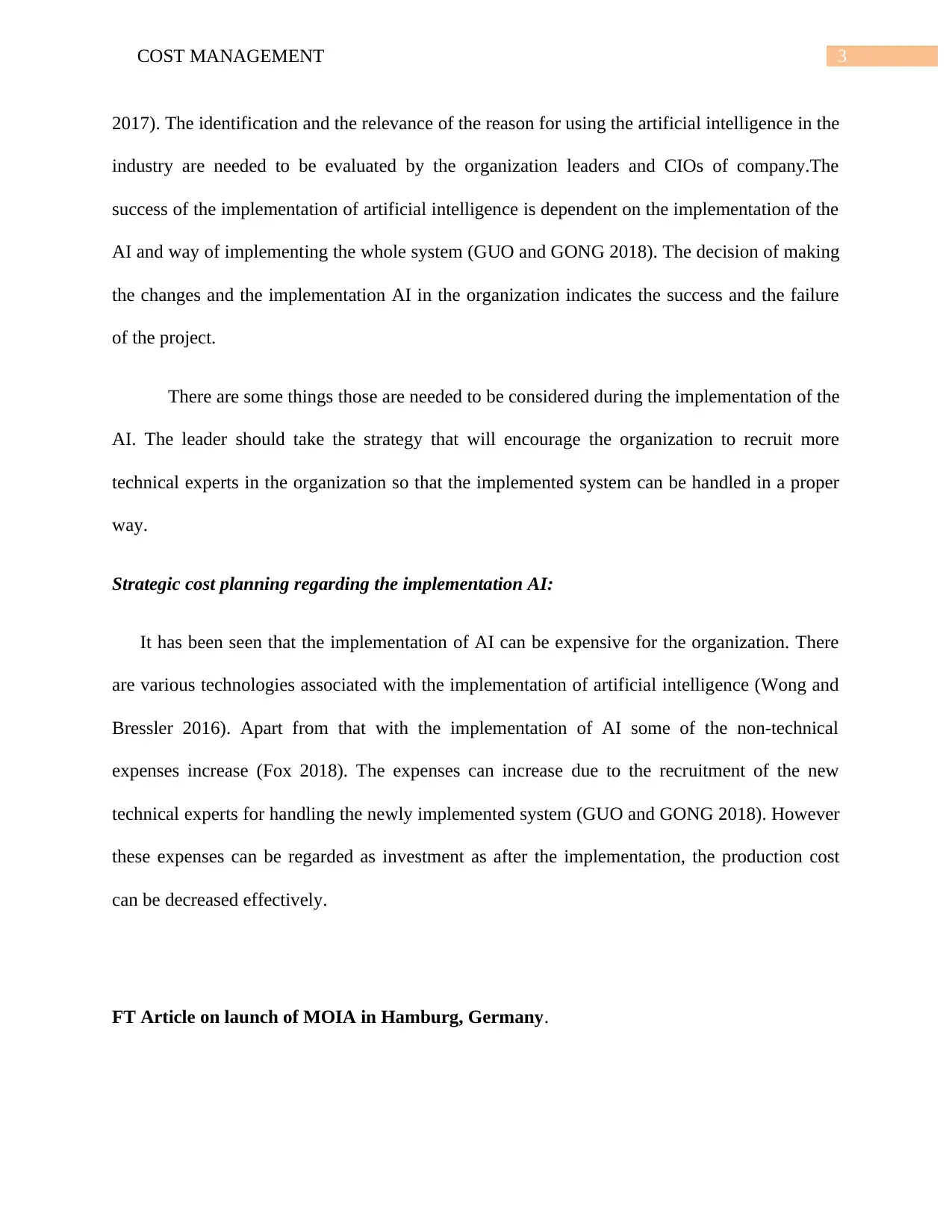
3COST MANAGEMENT
2017). The identification and the relevance of the reason for using the artificial intelligence in the
industry are needed to be evaluated by the organization leaders and CIOs of company.The
success of the implementation of artificial intelligence is dependent on the implementation of the
AI and way of implementing the whole system (GUO and GONG 2018). The decision of making
the changes and the implementation AI in the organization indicates the success and the failure
of the project.
There are some things those are needed to be considered during the implementation of the
AI. The leader should take the strategy that will encourage the organization to recruit more
technical experts in the organization so that the implemented system can be handled in a proper
way.
Strategic cost planning regarding the implementation AI:
It has been seen that the implementation of AI can be expensive for the organization. There
are various technologies associated with the implementation of artificial intelligence (Wong and
Bressler 2016). Apart from that with the implementation of AI some of the non-technical
expenses increase (Fox 2018). The expenses can increase due to the recruitment of the new
technical experts for handling the newly implemented system (GUO and GONG 2018). However
these expenses can be regarded as investment as after the implementation, the production cost
can be decreased effectively.
FT Article on launch of MOIA in Hamburg, Germany.
2017). The identification and the relevance of the reason for using the artificial intelligence in the
industry are needed to be evaluated by the organization leaders and CIOs of company.The
success of the implementation of artificial intelligence is dependent on the implementation of the
AI and way of implementing the whole system (GUO and GONG 2018). The decision of making
the changes and the implementation AI in the organization indicates the success and the failure
of the project.
There are some things those are needed to be considered during the implementation of the
AI. The leader should take the strategy that will encourage the organization to recruit more
technical experts in the organization so that the implemented system can be handled in a proper
way.
Strategic cost planning regarding the implementation AI:
It has been seen that the implementation of AI can be expensive for the organization. There
are various technologies associated with the implementation of artificial intelligence (Wong and
Bressler 2016). Apart from that with the implementation of AI some of the non-technical
expenses increase (Fox 2018). The expenses can increase due to the recruitment of the new
technical experts for handling the newly implemented system (GUO and GONG 2018). However
these expenses can be regarded as investment as after the implementation, the production cost
can be decreased effectively.
FT Article on launch of MOIA in Hamburg, Germany.
Paraphrase This Document
Need a fresh take? Get an instant paraphrase of this document with our AI Paraphraser
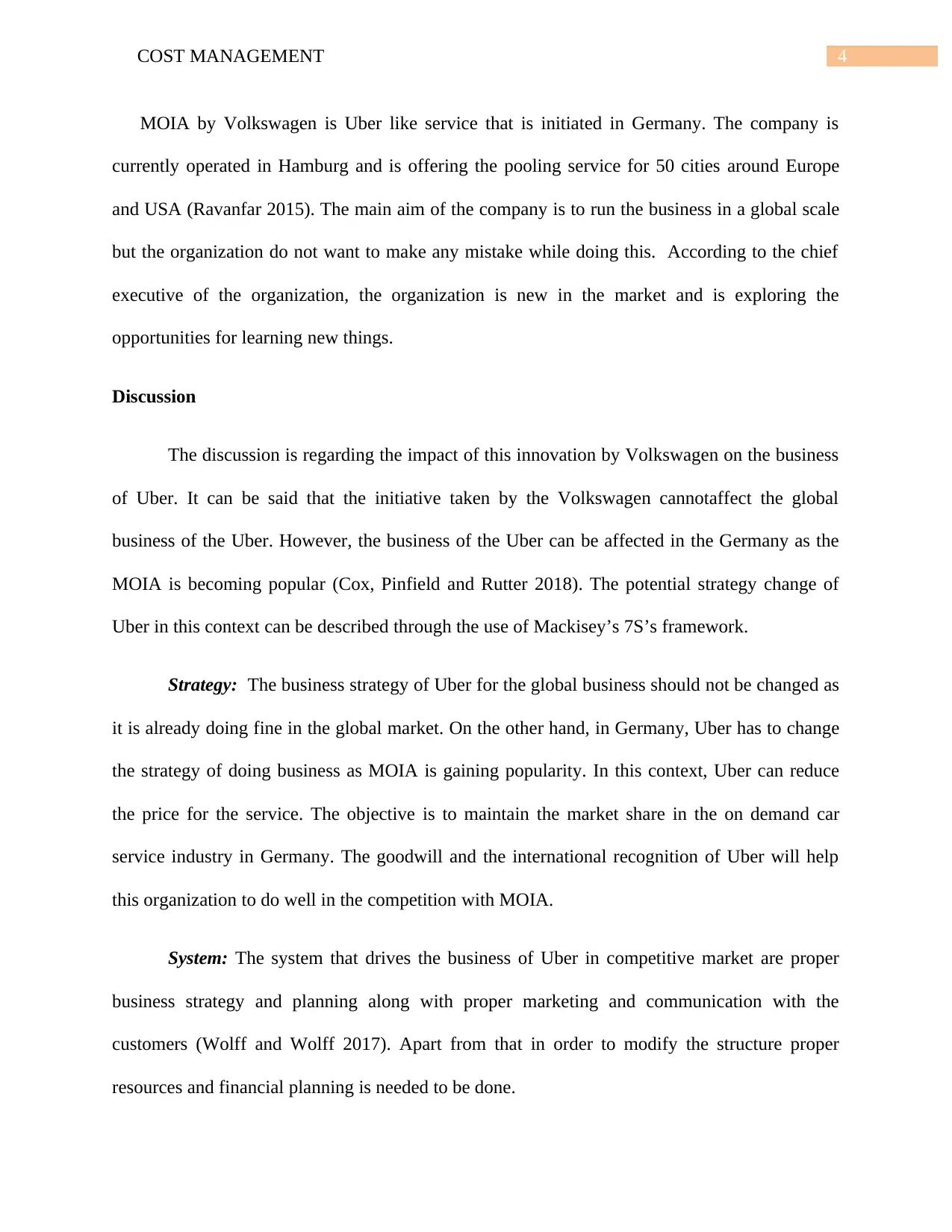
4COST MANAGEMENT
MOIA by Volkswagen is Uber like service that is initiated in Germany. The company is
currently operated in Hamburg and is offering the pooling service for 50 cities around Europe
and USA (Ravanfar 2015). The main aim of the company is to run the business in a global scale
but the organization do not want to make any mistake while doing this. According to the chief
executive of the organization, the organization is new in the market and is exploring the
opportunities for learning new things.
Discussion
The discussion is regarding the impact of this innovation by Volkswagen on the business
of Uber. It can be said that the initiative taken by the Volkswagen cannotaffect the global
business of the Uber. However, the business of the Uber can be affected in the Germany as the
MOIA is becoming popular (Cox, Pinfield and Rutter 2018). The potential strategy change of
Uber in this context can be described through the use of Mackisey’s 7S’s framework.
Strategy: The business strategy of Uber for the global business should not be changed as
it is already doing fine in the global market. On the other hand, in Germany, Uber has to change
the strategy of doing business as MOIA is gaining popularity. In this context, Uber can reduce
the price for the service. The objective is to maintain the market share in the on demand car
service industry in Germany. The goodwill and the international recognition of Uber will help
this organization to do well in the competition with MOIA.
System: The system that drives the business of Uber in competitive market are proper
business strategy and planning along with proper marketing and communication with the
customers (Wolff and Wolff 2017). Apart from that in order to modify the structure proper
resources and financial planning is needed to be done.
MOIA by Volkswagen is Uber like service that is initiated in Germany. The company is
currently operated in Hamburg and is offering the pooling service for 50 cities around Europe
and USA (Ravanfar 2015). The main aim of the company is to run the business in a global scale
but the organization do not want to make any mistake while doing this. According to the chief
executive of the organization, the organization is new in the market and is exploring the
opportunities for learning new things.
Discussion
The discussion is regarding the impact of this innovation by Volkswagen on the business
of Uber. It can be said that the initiative taken by the Volkswagen cannotaffect the global
business of the Uber. However, the business of the Uber can be affected in the Germany as the
MOIA is becoming popular (Cox, Pinfield and Rutter 2018). The potential strategy change of
Uber in this context can be described through the use of Mackisey’s 7S’s framework.
Strategy: The business strategy of Uber for the global business should not be changed as
it is already doing fine in the global market. On the other hand, in Germany, Uber has to change
the strategy of doing business as MOIA is gaining popularity. In this context, Uber can reduce
the price for the service. The objective is to maintain the market share in the on demand car
service industry in Germany. The goodwill and the international recognition of Uber will help
this organization to do well in the competition with MOIA.
System: The system that drives the business of Uber in competitive market are proper
business strategy and planning along with proper marketing and communication with the
customers (Wolff and Wolff 2017). Apart from that in order to modify the structure proper
resources and financial planning is needed to be done.
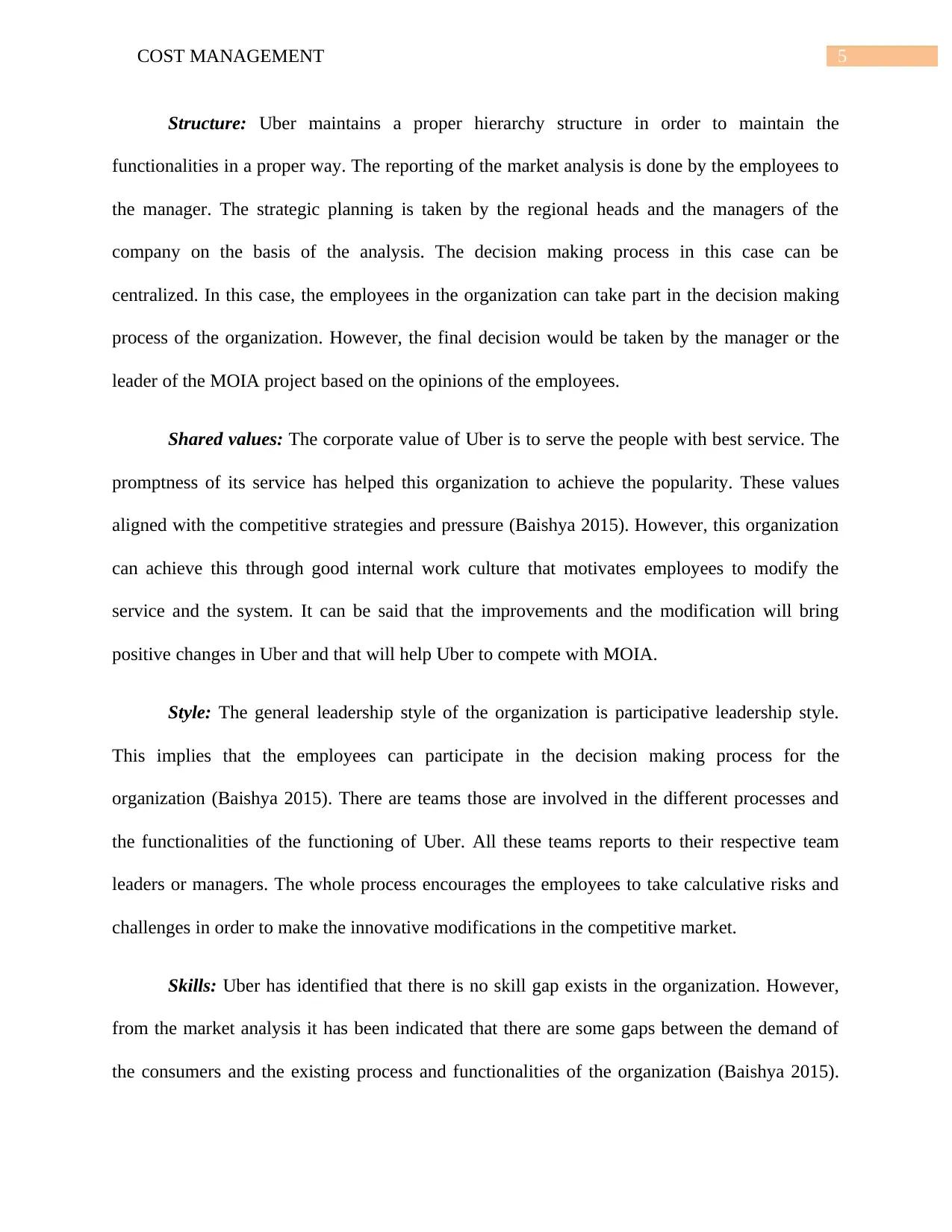
5COST MANAGEMENT
Structure: Uber maintains a proper hierarchy structure in order to maintain the
functionalities in a proper way. The reporting of the market analysis is done by the employees to
the manager. The strategic planning is taken by the regional heads and the managers of the
company on the basis of the analysis. The decision making process in this case can be
centralized. In this case, the employees in the organization can take part in the decision making
process of the organization. However, the final decision would be taken by the manager or the
leader of the MOIA project based on the opinions of the employees.
Shared values: The corporate value of Uber is to serve the people with best service. The
promptness of its service has helped this organization to achieve the popularity. These values
aligned with the competitive strategies and pressure (Baishya 2015). However, this organization
can achieve this through good internal work culture that motivates employees to modify the
service and the system. It can be said that the improvements and the modification will bring
positive changes in Uber and that will help Uber to compete with MOIA.
Style: The general leadership style of the organization is participative leadership style.
This implies that the employees can participate in the decision making process for the
organization (Baishya 2015). There are teams those are involved in the different processes and
the functionalities of the functioning of Uber. All these teams reports to their respective team
leaders or managers. The whole process encourages the employees to take calculative risks and
challenges in order to make the innovative modifications in the competitive market.
Skills: Uber has identified that there is no skill gap exists in the organization. However,
from the market analysis it has been indicated that there are some gaps between the demand of
the consumers and the existing process and functionalities of the organization (Baishya 2015).
Structure: Uber maintains a proper hierarchy structure in order to maintain the
functionalities in a proper way. The reporting of the market analysis is done by the employees to
the manager. The strategic planning is taken by the regional heads and the managers of the
company on the basis of the analysis. The decision making process in this case can be
centralized. In this case, the employees in the organization can take part in the decision making
process of the organization. However, the final decision would be taken by the manager or the
leader of the MOIA project based on the opinions of the employees.
Shared values: The corporate value of Uber is to serve the people with best service. The
promptness of its service has helped this organization to achieve the popularity. These values
aligned with the competitive strategies and pressure (Baishya 2015). However, this organization
can achieve this through good internal work culture that motivates employees to modify the
service and the system. It can be said that the improvements and the modification will bring
positive changes in Uber and that will help Uber to compete with MOIA.
Style: The general leadership style of the organization is participative leadership style.
This implies that the employees can participate in the decision making process for the
organization (Baishya 2015). There are teams those are involved in the different processes and
the functionalities of the functioning of Uber. All these teams reports to their respective team
leaders or managers. The whole process encourages the employees to take calculative risks and
challenges in order to make the innovative modifications in the competitive market.
Skills: Uber has identified that there is no skill gap exists in the organization. However,
from the market analysis it has been indicated that there are some gaps between the demand of
the consumers and the existing process and functionalities of the organization (Baishya 2015).
⊘ This is a preview!⊘
Do you want full access?
Subscribe today to unlock all pages.

Trusted by 1+ million students worldwide
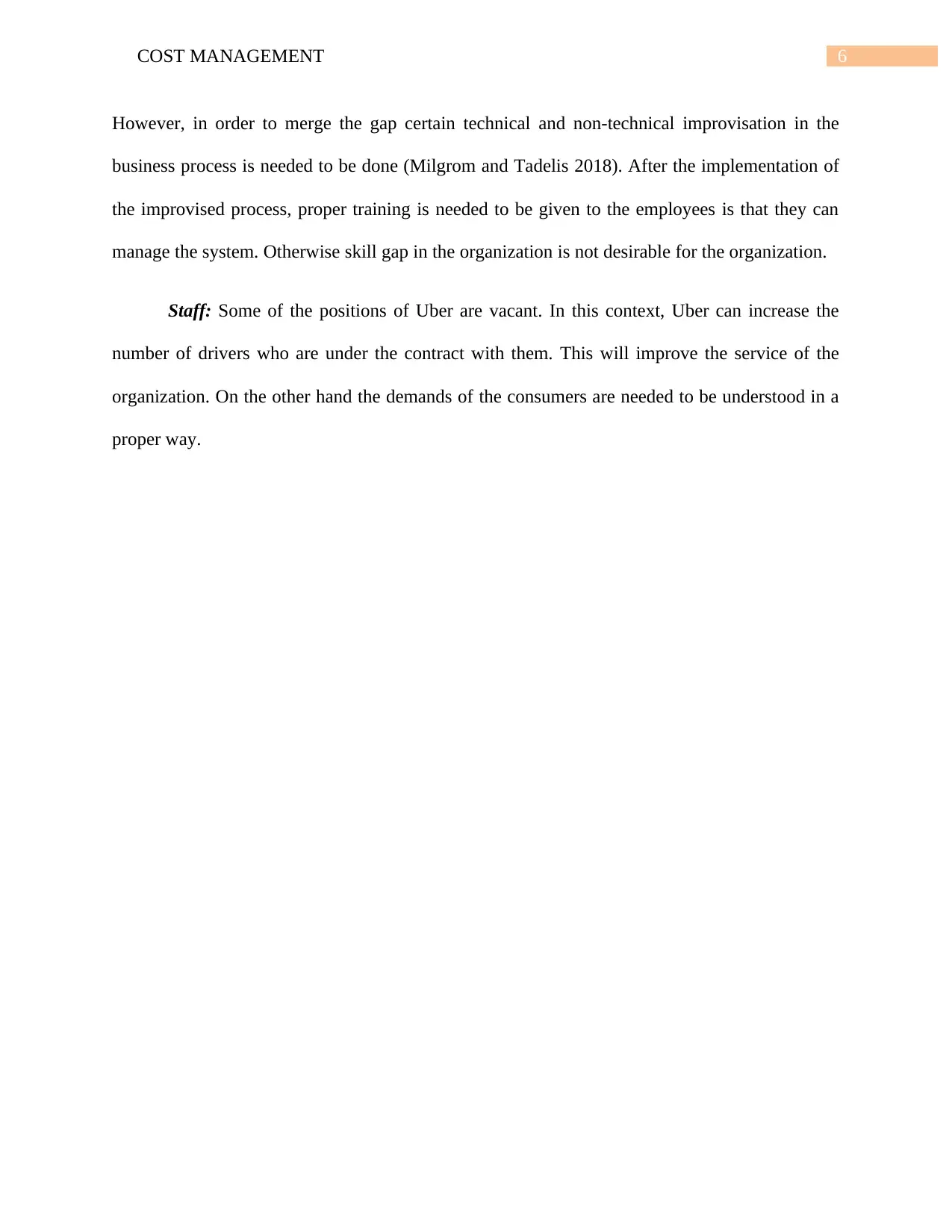
6COST MANAGEMENT
However, in order to merge the gap certain technical and non-technical improvisation in the
business process is needed to be done (Milgrom and Tadelis 2018). After the implementation of
the improvised process, proper training is needed to be given to the employees is that they can
manage the system. Otherwise skill gap in the organization is not desirable for the organization.
Staff: Some of the positions of Uber are vacant. In this context, Uber can increase the
number of drivers who are under the contract with them. This will improve the service of the
organization. On the other hand the demands of the consumers are needed to be understood in a
proper way.
However, in order to merge the gap certain technical and non-technical improvisation in the
business process is needed to be done (Milgrom and Tadelis 2018). After the implementation of
the improvised process, proper training is needed to be given to the employees is that they can
manage the system. Otherwise skill gap in the organization is not desirable for the organization.
Staff: Some of the positions of Uber are vacant. In this context, Uber can increase the
number of drivers who are under the contract with them. This will improve the service of the
organization. On the other hand the demands of the consumers are needed to be understood in a
proper way.
Paraphrase This Document
Need a fresh take? Get an instant paraphrase of this document with our AI Paraphraser
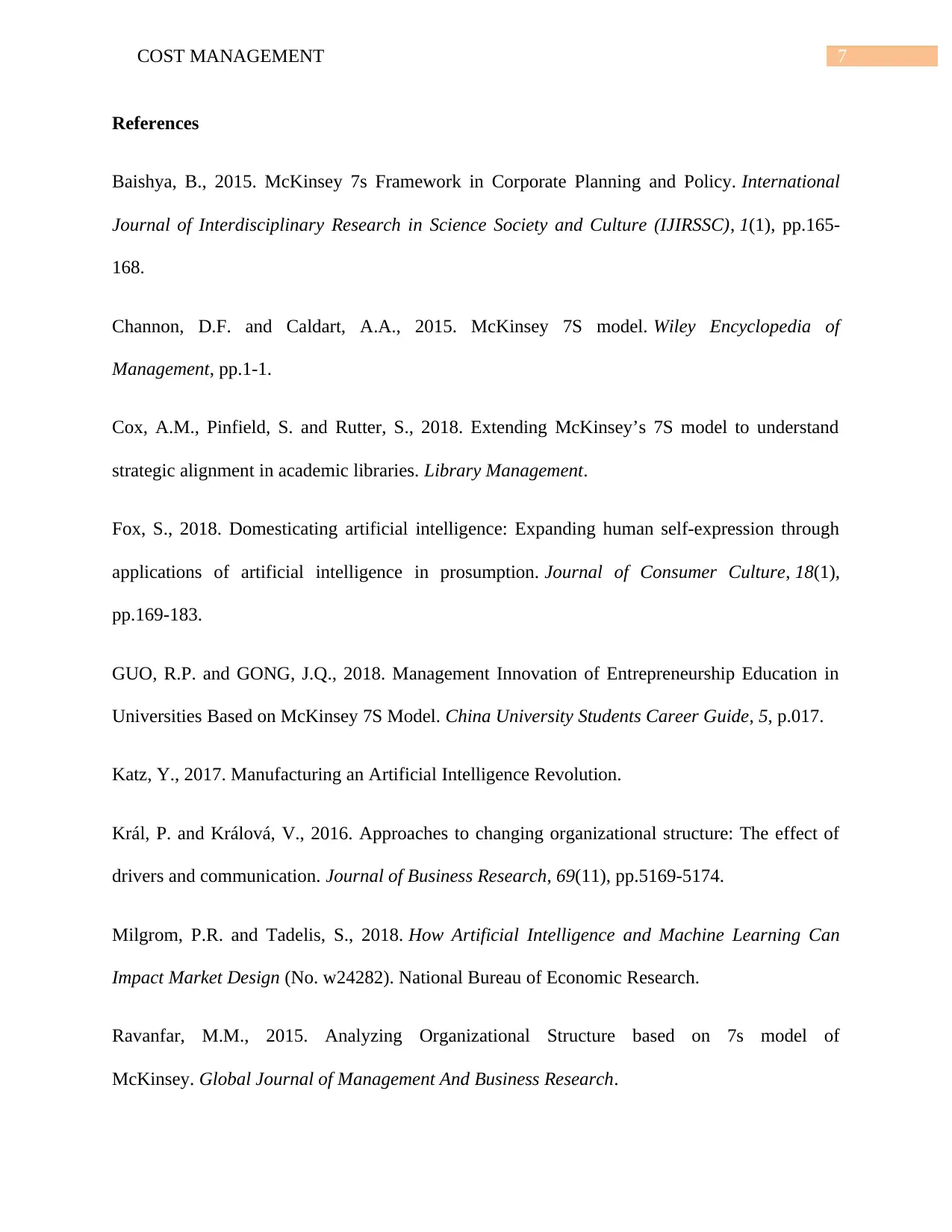
7COST MANAGEMENT
References
Baishya, B., 2015. McKinsey 7s Framework in Corporate Planning and Policy. International
Journal of Interdisciplinary Research in Science Society and Culture (IJIRSSC), 1(1), pp.165-
168.
Channon, D.F. and Caldart, A.A., 2015. McKinsey 7S model. Wiley Encyclopedia of
Management, pp.1-1.
Cox, A.M., Pinfield, S. and Rutter, S., 2018. Extending McKinsey’s 7S model to understand
strategic alignment in academic libraries. Library Management.
Fox, S., 2018. Domesticating artificial intelligence: Expanding human self-expression through
applications of artificial intelligence in prosumption. Journal of Consumer Culture, 18(1),
pp.169-183.
GUO, R.P. and GONG, J.Q., 2018. Management Innovation of Entrepreneurship Education in
Universities Based on McKinsey 7S Model. China University Students Career Guide, 5, p.017.
Katz, Y., 2017. Manufacturing an Artificial Intelligence Revolution.
Král, P. and Králová, V., 2016. Approaches to changing organizational structure: The effect of
drivers and communication. Journal of Business Research, 69(11), pp.5169-5174.
Milgrom, P.R. and Tadelis, S., 2018. How Artificial Intelligence and Machine Learning Can
Impact Market Design (No. w24282). National Bureau of Economic Research.
Ravanfar, M.M., 2015. Analyzing Organizational Structure based on 7s model of
McKinsey. Global Journal of Management And Business Research.
References
Baishya, B., 2015. McKinsey 7s Framework in Corporate Planning and Policy. International
Journal of Interdisciplinary Research in Science Society and Culture (IJIRSSC), 1(1), pp.165-
168.
Channon, D.F. and Caldart, A.A., 2015. McKinsey 7S model. Wiley Encyclopedia of
Management, pp.1-1.
Cox, A.M., Pinfield, S. and Rutter, S., 2018. Extending McKinsey’s 7S model to understand
strategic alignment in academic libraries. Library Management.
Fox, S., 2018. Domesticating artificial intelligence: Expanding human self-expression through
applications of artificial intelligence in prosumption. Journal of Consumer Culture, 18(1),
pp.169-183.
GUO, R.P. and GONG, J.Q., 2018. Management Innovation of Entrepreneurship Education in
Universities Based on McKinsey 7S Model. China University Students Career Guide, 5, p.017.
Katz, Y., 2017. Manufacturing an Artificial Intelligence Revolution.
Král, P. and Králová, V., 2016. Approaches to changing organizational structure: The effect of
drivers and communication. Journal of Business Research, 69(11), pp.5169-5174.
Milgrom, P.R. and Tadelis, S., 2018. How Artificial Intelligence and Machine Learning Can
Impact Market Design (No. w24282). National Bureau of Economic Research.
Ravanfar, M.M., 2015. Analyzing Organizational Structure based on 7s model of
McKinsey. Global Journal of Management And Business Research.
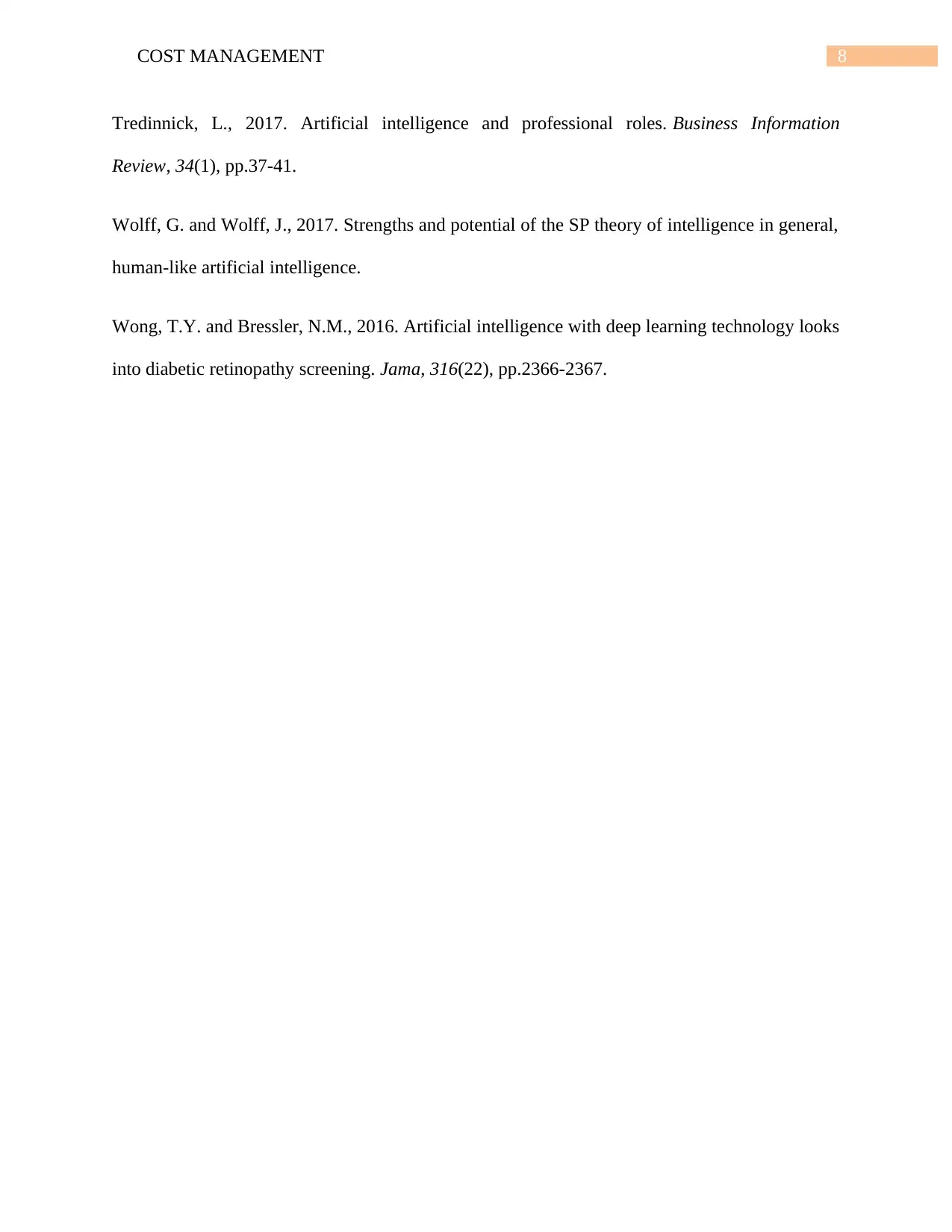
8COST MANAGEMENT
Tredinnick, L., 2017. Artificial intelligence and professional roles. Business Information
Review, 34(1), pp.37-41.
Wolff, G. and Wolff, J., 2017. Strengths and potential of the SP theory of intelligence in general,
human-like artificial intelligence.
Wong, T.Y. and Bressler, N.M., 2016. Artificial intelligence with deep learning technology looks
into diabetic retinopathy screening. Jama, 316(22), pp.2366-2367.
Tredinnick, L., 2017. Artificial intelligence and professional roles. Business Information
Review, 34(1), pp.37-41.
Wolff, G. and Wolff, J., 2017. Strengths and potential of the SP theory of intelligence in general,
human-like artificial intelligence.
Wong, T.Y. and Bressler, N.M., 2016. Artificial intelligence with deep learning technology looks
into diabetic retinopathy screening. Jama, 316(22), pp.2366-2367.
⊘ This is a preview!⊘
Do you want full access?
Subscribe today to unlock all pages.

Trusted by 1+ million students worldwide
1 out of 9
Related Documents
Your All-in-One AI-Powered Toolkit for Academic Success.
+13062052269
info@desklib.com
Available 24*7 on WhatsApp / Email
![[object Object]](/_next/static/media/star-bottom.7253800d.svg)
Unlock your academic potential
Copyright © 2020–2025 A2Z Services. All Rights Reserved. Developed and managed by ZUCOL.





